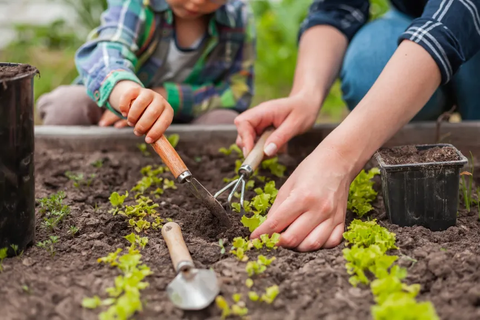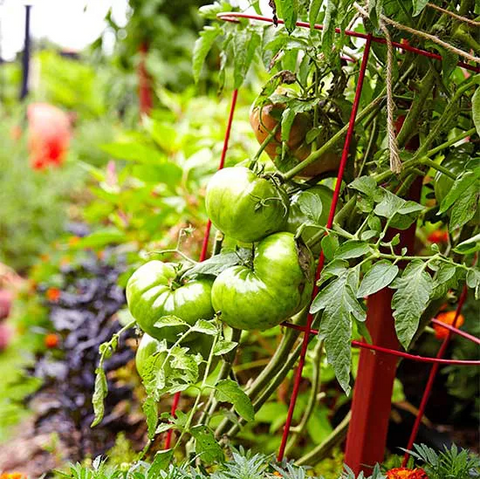Gardening in raised beds offers numerous advantages, from better soil drainage to easier weed control. However, one often underutilized aspect of raised bed gardening is the opportunity to incorporate trellises. Trellises serve as both functional and aesthetic elements in your garden, allowing you to cultivate climbing plants and create vertical greenery. In this comprehensive guide, we'll explore the world of raised bed trellis designs, from the benefits they offer to creative ideas for supporting your climbing plants.

The Advantages of Raised Bed Gardening
Before delving into trellis designs, let's briefly revisit the benefits of gardening in raised beds:
- Improved Soil Quality: Raised beds typically contain a mix of high-quality soil and organic matter, promoting healthy root development and better plant growth.
- Better Drainage: The elevated nature of raised beds ensures excess water drains away, reducing the risk of waterlogged roots and root rot.
- Warmer Soil: Raised beds warm up more quickly in the spring, extending the growing season and allowing for earlier planting.
- Easier Maintenance: Raised beds are easier to weed, as you can access them without stepping on the soil and compacting it.
- Enhanced Pest Control: Raised beds can be fitted with pest barriers, such as row covers or netting, to protect your plants from unwanted visitors.
- Accessibility: The height of raised beds makes gardening more accessible, particularly for those with mobility issues.
The Role of Trellises in Raised Bed Gardening
Now, let's focus on the star of our discussion: trellises. Trellises are vertical structures used to support climbing plants, such as beans, peas, cucumbers, and various vining flowers. Here's why they are invaluable in raised bed gardening:
- Space Optimization: When you grow climbing plants vertically, you make efficient use of space. This is particularly crucial in smaller gardens where horizontal space is limited.
- Aesthetic Appeal: Trellises can add visual interest to your garden, creating an attractive backdrop of greenery or blossoms that contrasts with your raised beds.
- Better Air Circulation: Elevating plants with trellises improves air circulation, reducing the risk of fungal diseases and promoting healthier growth.
- Easier Harvesting: Picking fruits or vegetables from trellised plants is a breeze compared to searching through sprawling vines on the ground.
- Protection from Soil-Borne Pests: Elevating your plants can help protect them from soil-borne pests and diseases.

Trellis Design Considerations
Before choosing a trellis design for your raised beds, consider these factors:
Plant Type
- Different climbing plants have varying requirements. Some may need sturdier structures, while others can thrive on lighter trellises.
Weight
- Consider the weight of your mature plants, especially when they are laden with fruits. Ensure your trellis can support the load without toppling.
Aesthetic Preferences
- Trellises come in various materials, colors, and designs. Choose one that complements your garden's aesthetic.
Durability
- Invest in quality materials that can withstand the elements. You want your trellis to last for many growing seasons.
Space
- Determine the available space in your raised bed. Some trellises are more compact, while others may require more room.
Creative Raised Bed Trellis Designs
Now that you understand the importance of trellises in raised bed gardening, let's explore some creative designs that you can consider for your own garden:
1. A-Frame Trellis
- This classic design resembles an A-frame, providing support on both sides. It's perfect for beans, peas, and cucumbers.
2. Arched Trellis
- Create a romantic and whimsical garden by adding arched trellises. They can frame your raised beds beautifully.
3. Obelisk Trellis
- Obelisk trellises add a touch of elegance to your garden. They are excellent for climbing flowers like sweet peas.
4. Grid Trellis
- For a minimalist look, opt for a grid trellis. It provides a clean structure for plants like tomatoes and peppers.
5. Cattle Panel Trellis
- Sturdy and versatile, cattle panels make excellent trellises. They can be bent into arches or used as flat supports.
6. Espalier Trellis
- Espalier trellises create a formal and space-efficient design, training fruit trees or berry bushes along a flat plane.
7. Bamboo Teepee
- Embrace eco-friendliness by using bamboo poles to create teepee trellises. They add a rustic touch to your garden.
8. Pergola Trellis
- If you have the space, consider integrating a pergola trellis. It offers shade and support for climbing plants.

Building Your Raised Bed Trellis
Now that you have a design in mind, here's a general guide to building your raised bed trellis:
Materials
- Depending on your chosen design, gather the necessary materials. Common options include wood, PVC pipes, metal, and bamboo.
Tools
- Ensure you have the right tools, such as a saw, drill, screws, and a level.
Measurements
- Measure your raised bed's dimensions and choose a trellis size that fits comfortably.
Assembly
- Follow the design plans or your creative instincts to assemble the trellis. Make sure it's sturdy and securely anchored in your raised bed's soil.
Planting
- Plant your climbing vegetables or flowers at the base of the trellis. Train them to grow upward as they mature.
Maintenance
- Regularly inspect and maintain your trellis throughout the growing season. Ensure it remains stable and provides adequate support.
Plants That Thrive on Trellises
Now that your trellis is ready, it's time to choose the right plants for vertical gardening. Here are some climbing plants that thrive on trellises:
- Climbing Beans: Varieties like pole beans or runner beans are perfect for trellises.
- Cucumbers: Vining cucumber plants can be trained to grow vertically.
- Tomatoes: Indeterminate tomato varieties benefit from trellises, as they can become quite tall.
- Peas: Sweet peas, snow peas, and snap peas all climb beautifully.
- Climbing Roses: Add a touch of romance to your garden with climbing rose varieties.
- Clematis: These stunning flowering vines come in various colors and are perfect for trellises
- Morning Glories: These annual vines provide vibrant colors and heart-shaped leaves.
- Nasturtiums: Both flowers and leaves are edible, making nasturtiums a delightful addition.
Conclusion
Incorporating trellises into your raised bed gardening not only maximizes space but also enhances the beauty and productivity of your garden. Whether you prefer a classic A-frame or an elegant arch, trellises offer endless possibilities for creativity and plant selection. So, get ready to transform your raised beds into vertical gardens that will impress both your eyes and your taste buds. Happy gardening!









